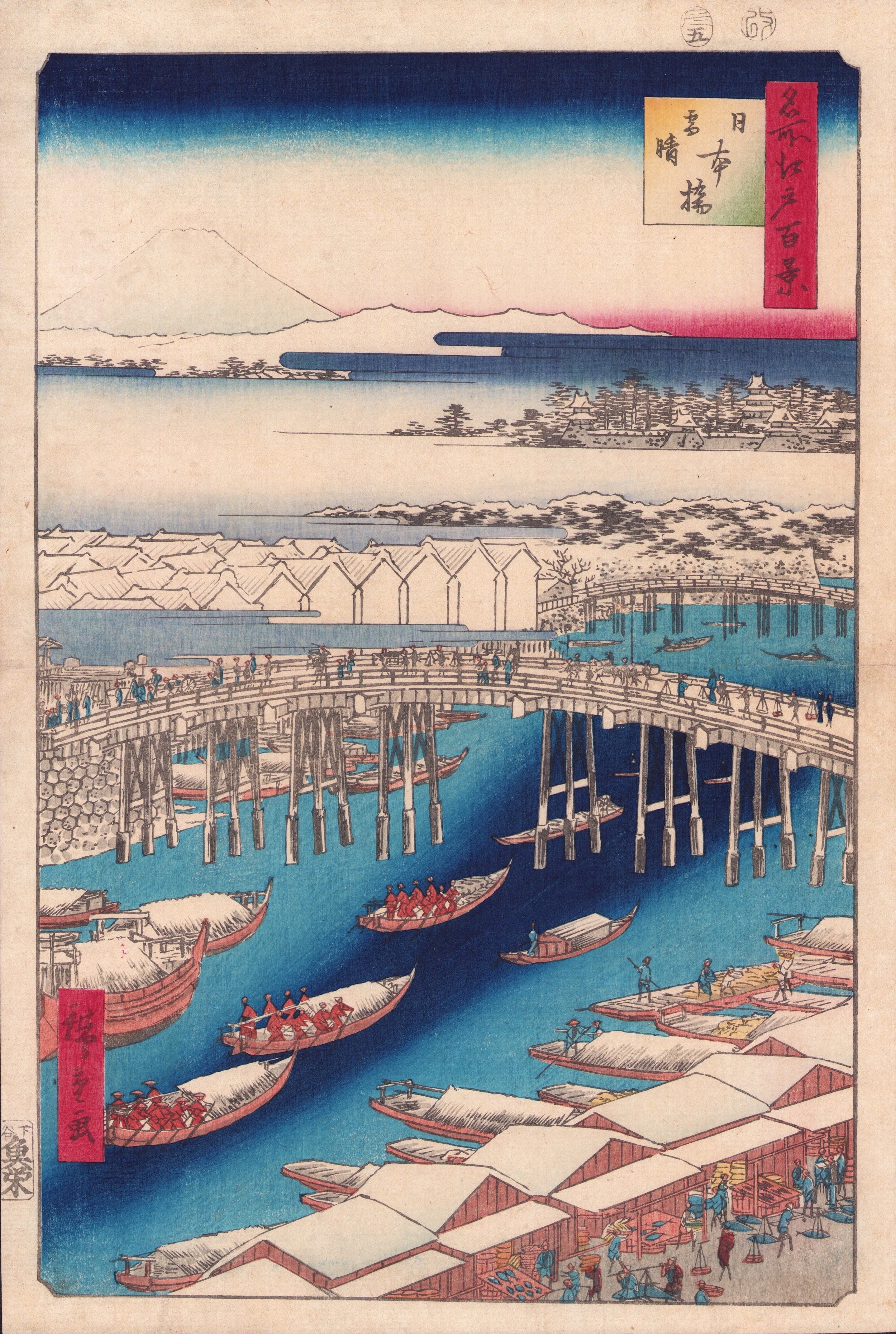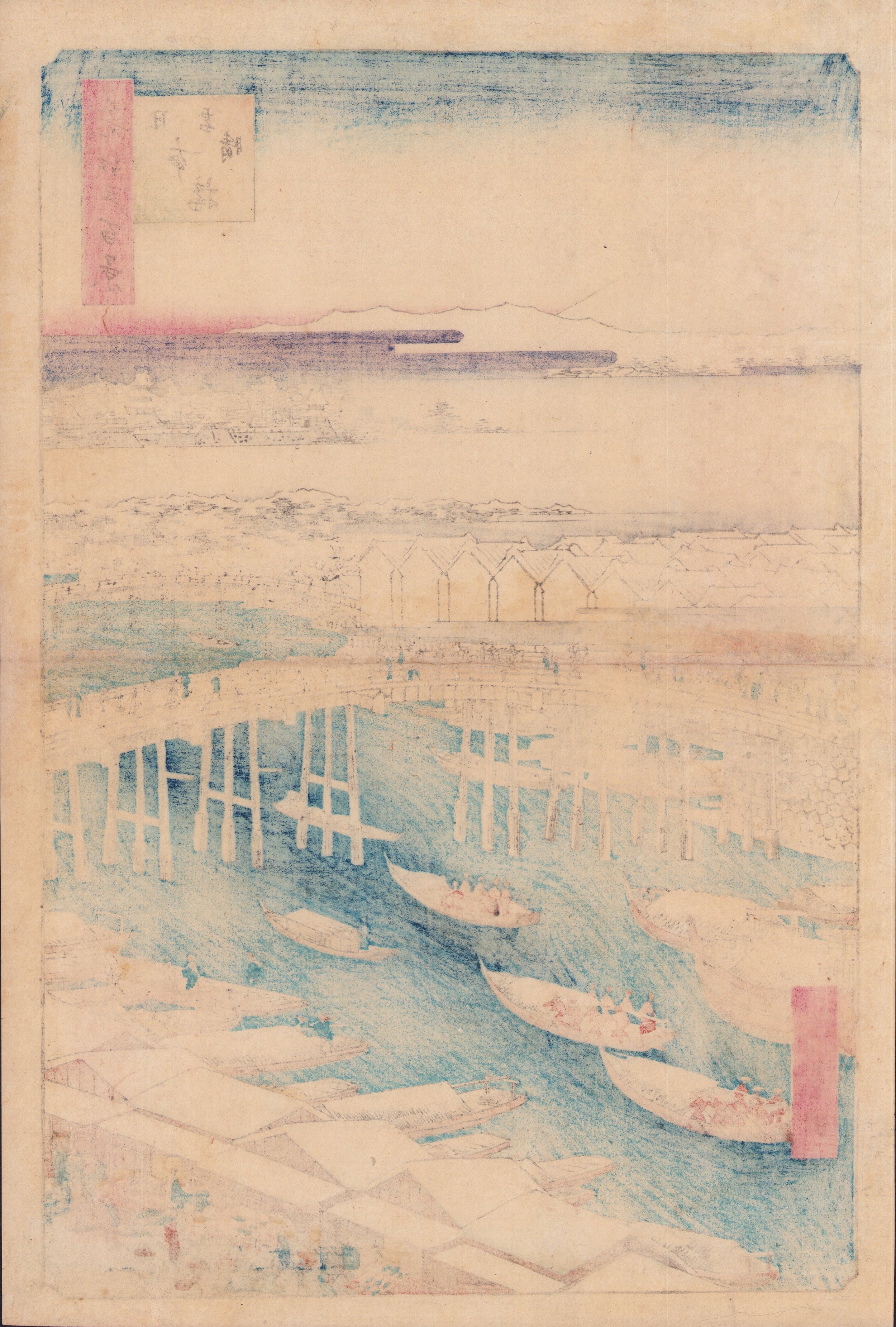Hiroshige | Clearing after Snow, 100 Famous Views of Edo
歌川広重 Utagawa Hiroshige (1797-1858)
名所江户百景 日本桥雪晴
Clearing after Snow, from the series of 100 Famous Views of Edo
1856
木版画 | 纵绘大判 | 36.5cm x 25.4cm
Woodblock-print | Oban tate-e | 36.5cm x 25.4cm
非常早期的版本、版次;颜色鲜艳;非常轻微的中间折痕
Very early edition and impression with great color; very slight centerfold
PRICE ON REQUEST
《名所江户百景》,是歌川广重于1856至1858年创作的竖版名所绘系列,为广重晚年乃至整个创作生涯中艺术水准最高的代表作之一。全系列包括目录在内共计119幅,以四季为主题,分为了春夏秋冬四部。本作分属于其中的春之部,是全系列的首图。
一如《东海道五十三次》《木曾街道六拾九次之内》等成功系列的开篇,画中的主角也是大名鼎鼎的日本桥。身为东海道、中山道、日光街道、奥州街道与甲州街道五条陆上干道的共同起点,日本桥的重要性不言而喻。其周边区域自江户时代起即人口众多,商业繁荣,堪称江户城乃至全日本的CBD。瑞雪兆丰年。正月里一个雪晴的晨间,从日本桥东北侧的鱼河岸上向西眺望,由近至远,将鱼河岸、日本桥、一石桥、江户城本丸御殿与富岳尽收眼底。
在江户时代的每个清早,鱼河岸都是全江户城最热闹的区域。一排排被雪覆盖屋顶的店铺鳞次栉比,数不清的鱼商与菜贩店前去来,算不尽的货船与渡舟铺后往返,“朝千两(一早交易额超过千两)”的名头,确是要如此的盛况才能保证。广重立足于“江户城的厨房”,以最生活化的场景,展现着城中的富足繁华。从这儿游上百姓餐桌的一尾尾鲜鱼,即是新年必不可少的风物诗。
On a snowy morning we look west from the northeast side of Nihonbashi Bridge, taking in the elegant curve of the span itself, Edo Castle, Honmaru Palace and all the panoramic energy and bustle of Edo during this, the first month of the year. Auspicious snow heralds a good harvest, so joy mixes with the icy air. Rows of shops with snow-covered roofs stand side by side near shouting fish mongers and vegetable vendors as cargo boats and ferries ply the river.
This is the first design from "One Hundred Views of Famous Places in Edo," generally held to be Hiroshige’s late-career masterpiece, which included 119 woodblock prints divided into four sections: spring, summer, autumn and winter. Nihonbashi was the starting point for the famed Tokaido and Kiso highways, and the heart of Edo and thus a great place to start any journey, or story.
This is a deluxe version with a gorgeous cartouche with subtle bokashi, and rich and vibrant colors. The juxtaposition of the blue of the sky and the water against the white of the snow is especially dynamic; you can almost feel the first hint of the sun’s warmth touching your skin as night brightens to day.
Interested in purchasing?
Please contact us.
歌川広重 Utagawa Hiroshige (1797-1858)
名所江户百景 日本桥雪晴
Clearing after Snow, from the series of 100 Famous Views of Edo
1856
木版画 | 纵绘大判 | 36.5cm x 25.4cm
Woodblock-print | Oban tate-e | 36.5cm x 25.4cm
非常早期的版本、版次;颜色鲜艳;非常轻微的中间折痕
Very early edition and impression with great color; very slight centerfold
PRICE ON REQUEST
《名所江户百景》,是歌川广重于1856至1858年创作的竖版名所绘系列,为广重晚年乃至整个创作生涯中艺术水准最高的代表作之一。全系列包括目录在内共计119幅,以四季为主题,分为了春夏秋冬四部。本作分属于其中的春之部,是全系列的首图。
一如《东海道五十三次》《木曾街道六拾九次之内》等成功系列的开篇,画中的主角也是大名鼎鼎的日本桥。身为东海道、中山道、日光街道、奥州街道与甲州街道五条陆上干道的共同起点,日本桥的重要性不言而喻。其周边区域自江户时代起即人口众多,商业繁荣,堪称江户城乃至全日本的CBD。瑞雪兆丰年。正月里一个雪晴的晨间,从日本桥东北侧的鱼河岸上向西眺望,由近至远,将鱼河岸、日本桥、一石桥、江户城本丸御殿与富岳尽收眼底。
在江户时代的每个清早,鱼河岸都是全江户城最热闹的区域。一排排被雪覆盖屋顶的店铺鳞次栉比,数不清的鱼商与菜贩店前去来,算不尽的货船与渡舟铺后往返,“朝千两(一早交易额超过千两)”的名头,确是要如此的盛况才能保证。广重立足于“江户城的厨房”,以最生活化的场景,展现着城中的富足繁华。从这儿游上百姓餐桌的一尾尾鲜鱼,即是新年必不可少的风物诗。
On a snowy morning we look west from the northeast side of Nihonbashi Bridge, taking in the elegant curve of the span itself, Edo Castle, Honmaru Palace and all the panoramic energy and bustle of Edo during this, the first month of the year. Auspicious snow heralds a good harvest, so joy mixes with the icy air. Rows of shops with snow-covered roofs stand side by side near shouting fish mongers and vegetable vendors as cargo boats and ferries ply the river.
This is the first design from "One Hundred Views of Famous Places in Edo," generally held to be Hiroshige’s late-career masterpiece, which included 119 woodblock prints divided into four sections: spring, summer, autumn and winter. Nihonbashi was the starting point for the famed Tokaido and Kiso highways, and the heart of Edo and thus a great place to start any journey, or story.
This is a deluxe version with a gorgeous cartouche with subtle bokashi, and rich and vibrant colors. The juxtaposition of the blue of the sky and the water against the white of the snow is especially dynamic; you can almost feel the first hint of the sun’s warmth touching your skin as night brightens to day.
Interested in purchasing?
Please contact us.
歌川広重 Utagawa Hiroshige (1797-1858)
名所江户百景 日本桥雪晴
Clearing after Snow, from the series of 100 Famous Views of Edo
1856
木版画 | 纵绘大判 | 36.5cm x 25.4cm
Woodblock-print | Oban tate-e | 36.5cm x 25.4cm
非常早期的版本、版次;颜色鲜艳;非常轻微的中间折痕
Very early edition and impression with great color; very slight centerfold
PRICE ON REQUEST
《名所江户百景》,是歌川广重于1856至1858年创作的竖版名所绘系列,为广重晚年乃至整个创作生涯中艺术水准最高的代表作之一。全系列包括目录在内共计119幅,以四季为主题,分为了春夏秋冬四部。本作分属于其中的春之部,是全系列的首图。
一如《东海道五十三次》《木曾街道六拾九次之内》等成功系列的开篇,画中的主角也是大名鼎鼎的日本桥。身为东海道、中山道、日光街道、奥州街道与甲州街道五条陆上干道的共同起点,日本桥的重要性不言而喻。其周边区域自江户时代起即人口众多,商业繁荣,堪称江户城乃至全日本的CBD。瑞雪兆丰年。正月里一个雪晴的晨间,从日本桥东北侧的鱼河岸上向西眺望,由近至远,将鱼河岸、日本桥、一石桥、江户城本丸御殿与富岳尽收眼底。
在江户时代的每个清早,鱼河岸都是全江户城最热闹的区域。一排排被雪覆盖屋顶的店铺鳞次栉比,数不清的鱼商与菜贩店前去来,算不尽的货船与渡舟铺后往返,“朝千两(一早交易额超过千两)”的名头,确是要如此的盛况才能保证。广重立足于“江户城的厨房”,以最生活化的场景,展现着城中的富足繁华。从这儿游上百姓餐桌的一尾尾鲜鱼,即是新年必不可少的风物诗。
On a snowy morning we look west from the northeast side of Nihonbashi Bridge, taking in the elegant curve of the span itself, Edo Castle, Honmaru Palace and all the panoramic energy and bustle of Edo during this, the first month of the year. Auspicious snow heralds a good harvest, so joy mixes with the icy air. Rows of shops with snow-covered roofs stand side by side near shouting fish mongers and vegetable vendors as cargo boats and ferries ply the river.
This is the first design from "One Hundred Views of Famous Places in Edo," generally held to be Hiroshige’s late-career masterpiece, which included 119 woodblock prints divided into four sections: spring, summer, autumn and winter. Nihonbashi was the starting point for the famed Tokaido and Kiso highways, and the heart of Edo and thus a great place to start any journey, or story.
This is a deluxe version with a gorgeous cartouche with subtle bokashi, and rich and vibrant colors. The juxtaposition of the blue of the sky and the water against the white of the snow is especially dynamic; you can almost feel the first hint of the sun’s warmth touching your skin as night brightens to day.
Interested in purchasing?
Please contact us.
Utagawa Hiroshige (1797-1858)
Ando Hiroshige (1897-1858) revolutionized the art of landscape prints during the Edo era, building on the success of his senior, Hokusai, but taking a more poetic and naturalist approach to portraying the beauty of Japan.
The son of a low-level Samurai assigned to the fire brigade in Edo, Hiroshige became a student of the Utagawa school as a young man. His first prints focused on beautiful women (bijin), and views of Edo. But in 1833 he began work on his most famous early work, his first series depicting the Tokaido, the "Great Sea Road" between Edo and Tokyo.
Today there is some controversy about this series. Initially, it was believed that Hiroshige had travelled the route along with a local lord (Daimyo) who was making a gift of horses to the Emperor. But more recent scholarship suggests Hiroshige never travelled the road himself, at least not the entire way, and made his designs using published guidebooks.
Nonetheless, the prints were wonderful and revolutionary. They embraced the seasons with a gentle lyricism missing from Hokusai's striking but stylized depictions. In Hiroshige's work, nature is sacred -- but it is always mixed with humanity, with travelers or little inns or bridges. There is a magical harmony between man and the elements.
His depiction of the seasons and weather is especially evocative. Snow blankets some views with a hushed silence, while rain streaks down furiously in others. In some prints natured is agitated; in others, calm prevails. Produced in a horizontal oban yoko-e format, the series was a smash hit.
The Tokaido series made Hiroshige famous, and he became incredible prolific. In the 1840s he produced many strong designs, but many mediocre ones, too, including several subsequent Tokaido series of varying quality.
In 1853, however, he made a big step. He turned his landscapes sideways, embracing a bold vertical oban tate-e format. This gave his designs new energy and a modern feel. The first of these was Famous Views of the Sixty-Odd Provinces. From them on, most of his most noted series were executed in this format.
He saved his greatest for his last. In 1856 he began work on 100 Famous Views of Edo, which many consider his most exceptional work. Here his home city was portrayed with energy and passion, and in these 119 designs he created an incredible record of a vanished place. In addition to the striking vertical format, he developed exciting new compositions, often juxtaposing a strong foreground element with a distant background.
Among the many famous images in this series are Squall at Ohashi and the Plum Garden in Komeido. Both of these were copied by Vincent Van Gogh, a great admirer of Hiroshige. Thus, the great Japanese artist had a profound effect on Western art.
Alas, his beloved Edo ended his life. Hiroshige was claimed by a cholera epidemic that swept the city in 1958. His pupil Shigenobu, who took the name Hiroshige II, completed The Famous Views of Edo.


